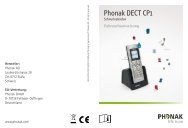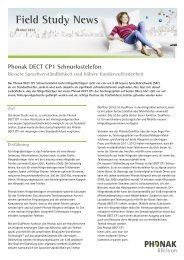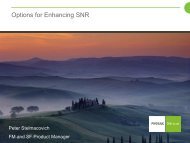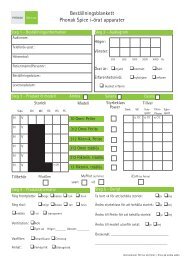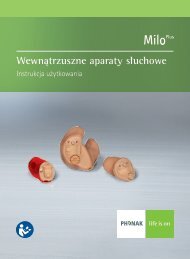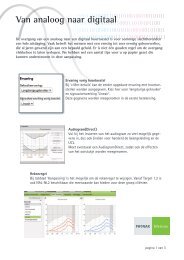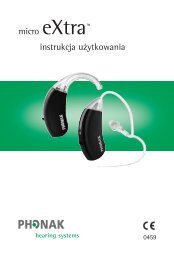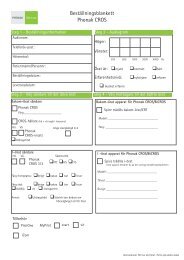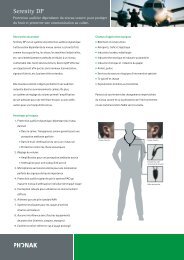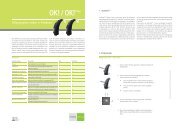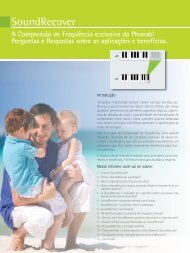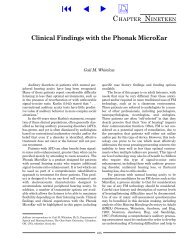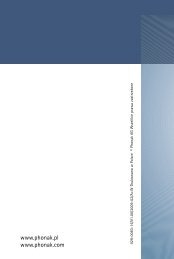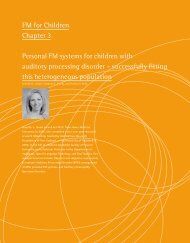DSL v5.0 for Clinicians - Phonak
DSL v5.0 for Clinicians - Phonak
DSL v5.0 for Clinicians - Phonak
Create successful ePaper yourself
Turn your PDF publications into a flip-book with our unique Google optimized e-Paper software.
<strong>DSL</strong> ® <strong>v5.0</strong>: The New <strong>DSL</strong> Method <strong>for</strong> Hearing<br />
Instrument Fitting in Children and Adults<br />
Richard Seewald<br />
National Centre <strong>for</strong> Audiology<br />
University of Western Ontario<br />
London Ontario Canada
Acknowledgements<br />
Marlene Bagatto<br />
Steve Beaulac<br />
Leonard Cornelisse<br />
Jillian Drake<br />
Judith Gravel<br />
Martyn Hyde<br />
Lorienne Jenstad<br />
Brenda Hoover<br />
Diana Laurnagaray<br />
Rachel Lui<br />
Shane Moodie<br />
Sheila Moodie<br />
John Pum<strong>for</strong>d<br />
Patricia Roush<br />
Susan Scollie<br />
David Stapells<br />
Jane Steinberg
Some Helpful Websites<br />
• <strong>DSL</strong> Website: http://www.dslio.com (English, Spanish,<br />
German and French)<br />
• Ontario Infant Hearing Program Protocols:<br />
http://ihp.mtsinai.on.ca/english/HealthProfessionals.htm<br />
•<strong>Phonak</strong> Website:<br />
* Conference Proceedings:<br />
http://www.phonak.com/professional/in<strong>for</strong>mationpool/proceedings.htm<br />
* VideoFocus Series:<br />
http://www.phonak.com/professional/pediatrics/focus.htm
Is it time <strong>for</strong> a new version of the <strong>DSL</strong> Method?<br />
1. Early hearing detection programs: Ensure seamless<br />
interface between diagnostic data and prescription;<br />
2. Provision of amplification by 6 months: Update RECD<br />
values <strong>for</strong> young infants;<br />
3. Advances in hearing instrument technology;<br />
4. Study and account <strong>for</strong> adult/child differences with<br />
regard to amplification preferences and requirements.
History of The <strong>DSL</strong> Method<br />
• Work on the algorithm began in 1979<br />
• Version 1 was completed in 1984 (pencil and paper)<br />
• The first software system (<strong>DSL</strong>v3.0) was released in 1991<br />
(<strong>DSL</strong> <strong>for</strong> fitting linear gain instruments)<br />
• <strong>DSL</strong>[i/o] <strong>for</strong> Windows was released in 1996<br />
(<strong>DSL</strong>[i/o] v4.0 <strong>for</strong> linear and WDRC instruments)<br />
• <strong>DSL</strong> m[i/o] <strong>v5.0</strong> <strong>for</strong> fitting multi-channel digital instruments<br />
was released to hearing instrument manufacturers<br />
in 2006
The <strong>DSL</strong> Method<br />
Assessment<br />
Electroacoustic<br />
Prescription<br />
Electroacoustic<br />
Verification
The <strong>DSL</strong> Method <strong>v5.0</strong><br />
Assessment<br />
• Compatibility with ABR<br />
Assessment Data<br />
• Updated RECD Norms<br />
Electroacoustic<br />
Prescription<br />
• The <strong>DSL</strong> m [i/o] Algorithm<br />
• Multi-channel Compression<br />
• Targets <strong>for</strong> Children & Adults<br />
• Targets <strong>for</strong> Quiet & Noise<br />
• Modifications <strong>for</strong> Conductive<br />
Losses and Binaural Fittings<br />
Electroacoustic<br />
Verification<br />
• Signal Types & Levels<br />
• Multi-Level Targets
Assessment Considerations <strong>for</strong> Fitting<br />
Infants with Amplification using <strong>DSL</strong> <strong>v5.0</strong>
Early Hearing Detection and<br />
Communication Development Programs<br />
• Goal: To identify infants with hearing loss and define<br />
the impairment by 3 months of age.<br />
• Intervention (amplification) to be initiated by 6<br />
months.
Two new developments in <strong>DSL</strong><br />
1) Improved the interface between ABR<br />
threshold estimations (in dB nHL) and data<br />
that are required <strong>for</strong> hearing aid prescription<br />
by <strong>DSL</strong>.<br />
2) Developed a more comprehensive data set <strong>for</strong><br />
predicting RECD values in infants and young<br />
children.
Background<br />
• Estimates of hearing sensitivity are derived from<br />
FS-ABR measurements<br />
• Hearing aid selection and fitting proceeds using<br />
ABR threshold estimates<br />
– Intervention is not postponed <strong>for</strong> collection of<br />
behavioral data
2k 50dB nHL<br />
0.5k 60dB nHL<br />
2k 40dB nHL<br />
0.5k 50dB nHL<br />
2k 30dB nHL<br />
0.5k 40dB nHL<br />
0 5 10 15 20 25<br />
msec<br />
0 5 10 15 20 25<br />
msec
Behavioral vs. Electrophysiological Assessment Procedures<br />
• dB HL<br />
• entire auditory system<br />
• long duration pure tones<br />
• standard calibration<br />
• dB nHL<br />
• measured from the brainstem<br />
• brief tone bursts or clicks<br />
• non-standard calibration
Some Issues……<br />
…….<br />
• For some ABR protocols (e.g., Stapells 2000),<br />
frequency-specific ABR threshold estimates (nHL)<br />
are not equivalent to behavioral thresholds (HL).<br />
• Fitting algorithms (e.g., <strong>DSL</strong> m[i/o]) use threshold<br />
in<strong>for</strong>mation in HL or eHL to calculate prescription.
A Sizable Gap in our Procedures….<br />
ABR<br />
Thresholds<br />
(nHL)<br />
Threshold<br />
Estimates <strong>for</strong><br />
Hearing Aid<br />
fitting(eHL)
ABR Threshold Estimation: nHL<br />
ABR<br />
500 Hz 60 dB nHL<br />
2000 Hz 40 dB nHL<br />
Can I enter my<br />
ABR results<br />
directly into<br />
<strong>DSL</strong>?
Fitting Hearing Aids from<br />
eHL Data<br />
• For some ABR protocols, corrections from nHL to<br />
Estimated Hearing Level (eHL) are needed be<strong>for</strong>e<br />
the hearing aid prescription can be calculated.
A Clinical Solution . . . .<br />
• Apply a correction to ABR thresholds (nHL) to<br />
obtain the Estimated Hearing Level (eHL)<br />
• The corrected nHL value represents a behavioral<br />
threshold (eHL) <strong>for</strong> the purposes of prescription.
Ontario Infant Hearing Program:<br />
Assessment Protocol<br />
Corrections <strong>for</strong> FS-ABR Measures:<br />
500 1000 2000 4000<br />
AC -15 -10 -5 0<br />
AC correction <strong>for</strong> 250 Hz = 25*
Sample Findings<br />
-10<br />
0<br />
Frequency (Hz)<br />
250 500 1000 2000 4000 6000<br />
8000<br />
Hearing Threshold Level (dB)<br />
10<br />
20<br />
30<br />
40<br />
50<br />
60<br />
70<br />
80<br />
90<br />
100<br />
110<br />
120<br />
X<br />
X X<br />
X X X
What about ear canal acoustics?<br />
• Large variability in ear canal SPL across infants<br />
and young children<br />
– Kruger 1987, Feigin et al 1989, Bagatto et al<br />
2002<br />
• Must account <strong>for</strong> this variability in both<br />
audiologic assessment and in hearing instrument<br />
fitting.
What about ear canal acoustics?<br />
35<br />
30<br />
25<br />
20<br />
RECD (dB)<br />
15<br />
10<br />
5<br />
0<br />
-5<br />
-10<br />
100 1000 10000<br />
Frequency (Hz)
The SPLogram<br />
140<br />
130<br />
120<br />
110<br />
100<br />
90<br />
80<br />
70<br />
60<br />
50<br />
X<br />
X<br />
X<br />
40<br />
30<br />
20<br />
10<br />
0<br />
125 250 500 1000 2000 4000 6000 8000<br />
Frequency (Hz)
Getting from nHL to dB SPL in the ear canal<br />
ABR dB nHL<br />
+<br />
Correction x<br />
Frequency<br />
=<br />
Threshold<br />
dB eHL<br />
+<br />
RECD<br />
How well does this work ??<br />
+<br />
RETSPL<br />
=<br />
Real Ear<br />
dB SPL
Accuracy of Predicting Behavioural<br />
Thresholds from ABR Threshold<br />
Estimations in RESPL<br />
Bagatto, Seewald, Scollie, Liu, & Hyde<br />
Trends in Amplification (2005)
Procedure<br />
• Subjects<br />
– 15 children & young adults with SNHL<br />
– 15 young adults with normal hearing<br />
• RECD measures<br />
• Behavioural audiometry<br />
– .5, 1, 2, 4kHz<br />
• FS-ABR threshold estimations<br />
– .5, 1, 2, 4kHz<br />
• Insert earphones used
HL<br />
nHL<br />
-correction<br />
eHL<br />
+ RECD<br />
+ RECD<br />
+ RETSPL<br />
+ RETSPL<br />
Real-ear SPL<br />
Real-ear SPL
120<br />
500 Hz<br />
120<br />
1000 Hz<br />
Behavioural Thresholds<br />
(dB SPL)<br />
100<br />
80<br />
60<br />
40<br />
20<br />
0<br />
0 20 40 60 80 100 120<br />
ABR Thresholds (dB SPL)<br />
Behavioural Thresholds<br />
(dB SPL)<br />
100<br />
80<br />
60<br />
40<br />
20<br />
r = 0.91 r = 0.98<br />
0<br />
0 20 40 60 80 100 120<br />
ABR Thresholds (dB SPL)<br />
120<br />
2000 Hz<br />
120<br />
4000 Hz<br />
Behavioural Thresholds (dB<br />
SPL)<br />
100<br />
80<br />
60<br />
40<br />
20<br />
0<br />
0 20 40 60 80 100 120<br />
ABR Thresholds (dB SPL)<br />
Behavioural Thresholds<br />
(dB SPL)<br />
100<br />
80<br />
60<br />
40<br />
r = 0.98<br />
20<br />
r = 0.99<br />
0<br />
0 20 40 60 80 100 120<br />
ABR Thresholds (dB SPL)
Summary of Results<br />
• Average difference between ABR and behavioral<br />
thresholds was 5.6 dB<br />
• 83 to 98% of variance accounted <strong>for</strong><br />
• Standard deviation ranged from ± 3 to ± 6<br />
– Reduced from previous studies
Conclusions<br />
• When certain variables are considered, it is possible<br />
to use ABR threshold estimates to accurately predict<br />
behavioral thresholds in RESPL<br />
– nHL to eHL corrections<br />
– Ear canal acoustics<br />
• <strong>DSL</strong> m[i/o] 5.0 will facilitate the application of nHL to<br />
eHL corrections and do all of the math <strong>for</strong> you !
<strong>DSL</strong> m[i/o] <strong>v5.0</strong> : Developments<br />
New RECD Values <strong>for</strong> Infants and Young Children
Predicted RECDs<br />
Predicted RECD values in previous<br />
versions of <strong>DSL</strong>:<br />
- foam tip coupling only<br />
- based on 12 month age ranges<br />
Newly developed predictions:<br />
- foam tip and earmold coupling<br />
- calculated to the nearest month
Updated Average RECD Values<br />
Real-Ear<br />
Ear-to-Coupler Difference (RECD)<br />
Predictions as a Function of Age <strong>for</strong> Two<br />
Coupling Procedures<br />
Bagatto, Scollie, Seewald, Moodie,& Hoover<br />
JAAA, 13, 2002
Predicted RECD Values<br />
Subjects<br />
- 392 infants & children<br />
- ages 1 month to 16 years<br />
- 141 ears used immittance tips<br />
- 251 ears used earmolds<br />
- normal otoscopic and immittance findings
Predicted RECD Values<br />
Primary Result:<br />
- High between-subject variability in<br />
RECD measures <strong>for</strong> children of<br />
the same age<br />
35<br />
30<br />
25<br />
20<br />
RECD (dB)<br />
15<br />
10<br />
5<br />
0<br />
-5<br />
-10<br />
100 1000 10000<br />
Frequency (Hz)
RECD values <strong>for</strong> earmolds
RECD values <strong>for</strong> earmolds
Predicted RECD Values<br />
Limitations:<br />
– all subjects had normal middle ear<br />
function<br />
– high variability in RECD measures<br />
associated with children of the same<br />
age<br />
There<strong>for</strong>e, whenever possible, predicted values<br />
should NOT replace the more precise RECD<br />
measurement.
Summary: What we need to fit amplification<br />
• Ear specific and frequency specific threshold estimates<br />
(eHL) <strong>for</strong> air and bone conduction stimuli (tone-burst<br />
ABR, ASSR, VRA).<br />
• Account <strong>for</strong> external ear acoustics in the assessment<br />
process (RECD).<br />
• Using RECD measures, predict the ear canal SPL at<br />
threshold across frequencies.<br />
• We can then move on to the prescription and fitting of<br />
amplification.
The SPLogram<br />
140<br />
130<br />
120<br />
110<br />
100<br />
90<br />
80<br />
70<br />
60<br />
50<br />
X<br />
X<br />
X<br />
40<br />
30<br />
20<br />
10<br />
0<br />
125 250 500 1000 2000 4000 6000 8000<br />
Frequency (Hz)
The <strong>DSL</strong> Method <strong>v5.0</strong><br />
Electroacoustic<br />
Prescription<br />
• The <strong>DSL</strong> m [i/o] Algorithm<br />
• Multi-channel Compression<br />
• Targets <strong>for</strong> Children & Adults<br />
• Targets <strong>for</strong> Quiet & Noise<br />
• Modifications <strong>for</strong> Conductive<br />
Losses and Binaural Fittings
Prescriptions <strong>for</strong> Infants and Children
<strong>DSL</strong> Prescriptions <strong>for</strong> Use with Children<br />
• Much of the work in developing <strong>DSL</strong> 5.0<br />
has been aimed at preserving most of the<br />
prescriptive characteristics <strong>for</strong> infants and<br />
children applied in previous versions of the<br />
<strong>DSL</strong> Method.
Preferred Listening Levels of Children<br />
who Use Hearing Aids:<br />
Comparison to Prescriptive Targets<br />
Scollie, Seewald, Moodie and Dekok<br />
JAAA 2000
Scollie et al. (2000)<br />
• N = 18 Mean age = 10 years<br />
Mild to Profound SN hearing loss<br />
• The subjects listened to average<br />
conversational speech and adjusted their VC<br />
to the level they preferred.<br />
• The subjects preferred VC setting, <strong>for</strong> an<br />
average speech input, was compared to <strong>DSL</strong><br />
& NAL prescribed settings.
Preferred Listening Levels in Children<br />
PLL / <strong>DSL</strong> Comparison<br />
Recommended Listening Level (dB)<br />
80<br />
60<br />
40<br />
20<br />
0<br />
<strong>DSL</strong><br />
0 20 40 60 80<br />
Preferred Listening Level (dB)
Preferred Listening Levels in Children<br />
PLL / <strong>DSL</strong> Comparison<br />
• On average, the children’s preferred<br />
listening level was 2 dB above the <strong>DSL</strong><br />
v4.1 prescribed setting.
Prescriptions <strong>for</strong> Adults
Adult / Child Preferred Listening Levels<br />
Laurnagaray & Seewald<br />
Trends in Amplification (2005)
Procedure<br />
• Subjects (n=72)<br />
– 24 children who were full-time hearing aid users<br />
– 24 adults with experience wearing hearing aids<br />
– 24 adults who were new hearing aid users<br />
• Prescriptive targets <strong>DSL</strong>[i/o]<br />
• New users provided with 15 to 20 day period of hearing<br />
instrument use<br />
• Volume control wheel set to minimum<br />
• Speech (RMS 60 dB SPL) via a loudspeaker in soundfield<br />
• Participant set VCW until talker sounded the best (repeated<br />
measure)
Adult/Child Preferred Listening Levels<br />
70<br />
60<br />
□ Children<br />
New Adult Users<br />
• Experienced Adult Users<br />
Preferred Listening Level<br />
50<br />
40<br />
30<br />
20<br />
10<br />
0<br />
0 10 20 30 40 50 60 70<br />
Recommended Listening Level
Implications <strong>for</strong> <strong>DSL</strong> <strong>v5.0</strong><br />
• <strong>DSL</strong> <strong>v5.0</strong> acknowledges that adults and children not only<br />
require, but also prefer different listening levels, thus:<br />
<strong>DSL</strong> <strong>v5.0</strong> is the first generic hearing instrument<br />
prescription algorithm to prescribe different sensation<br />
levels of amplified speech <strong>for</strong> children with congenital or<br />
early onset hearing loss versus adults with late onset<br />
hearing loss.
Electroacoustic Verification
Hearing Aid Verification<br />
The responsible clinician should want to know about the levels of<br />
sound that a hearing instrument delivers into the ear of an infant<br />
or young child. Consequently, comprehensive electroacoustic<br />
verification is an essential stage in the pediatric hearing<br />
instrument fitting process.<br />
Verification test signals are now available that can be used with<br />
modern DSP instruments in a valid way.<br />
To verify that audibility and appropriate output limiting have been<br />
achieved <strong>for</strong> a wide range of input signals it is imperative that<br />
real-ear measurements of hearing instrument per<strong>for</strong>mance be<br />
made.
Hearing Instrument Verification<br />
• In <strong>DSL</strong> <strong>v5.0</strong> we continue to recommend a simulated (ie. 2cc<br />
coupler + RECD) approach to electroacoustic verification –<br />
targets will be available on hearing instrument test systems<br />
<strong>for</strong> soft speech, average speech, loud speech and hearing<br />
instrument output limiting.<br />
• <strong>Clinicians</strong> are advised to use speech-based verification test<br />
signals whenever possible. If speech is not available as a<br />
test signal, the use of speech-weighted modulated noise is<br />
recommended.
Conclusion<br />
• In this presentation I have described some features<br />
of the new <strong>DSL</strong> Method v.5.0.<br />
• The developments incorporated into this version still<br />
reflect the original goals of the <strong>DSL</strong> Method we<br />
described mid-80’s:<br />
AUDIBILITY, COMFORT AND SAFETY<br />
SYSTEMATIC, SCIENTIFIC<br />
CLINICALLY FEASIBLE
Thank you !



